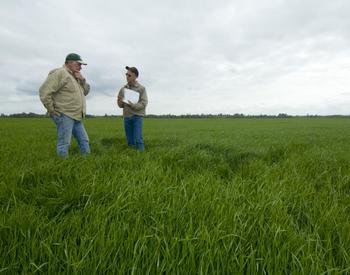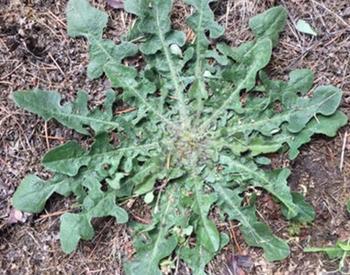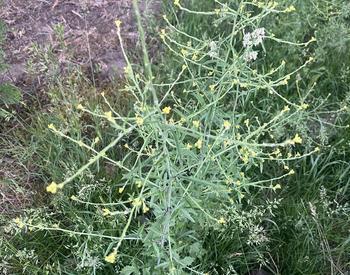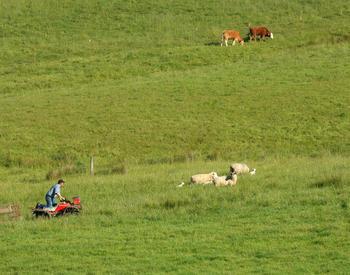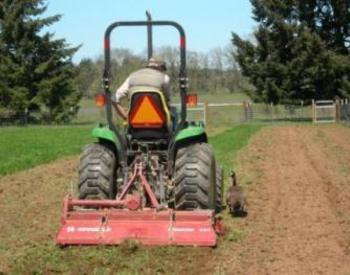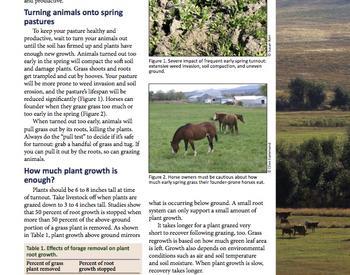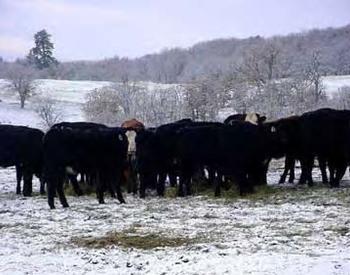Soil acidity is a universal problem for crop production in humid or rainy environments. Agricultural practices such as the addition of ammonium-N fertilizer add to soil acidity.
You can reduce soil acidity by applying lime, or calcium carbonate.
Cropping systems differ in the reason soil acidity limits growth, the ability to apply lime in crop sequence, and the economics, or return, of applying lime. Researchers have studied the need for lime and measured its benefits in coastal pastures research plots for more than a half century. The research work demonstrated that lime applied to soil with a pH of 5.5 or lower will increase forage yield and increase the longevity of orchardgrass, perennial ryegrass and white clover in pastures.
The years of research have not satisfied coastal Oregon pasture managers. They continue to question the need to apply lime and the benefit of its application. The primary questions are "How much does liming cost?" and "What do I get from applying lime?".
Coastal Oregon forage producers pay a relatively high price for lime that produces a modest yield increase. Lime costs more on the coast than in the Willamette Valley — typically 25% to 30% more per ton. The increase in yield for forage grass amended with lime varies, from 250 to 1,750 lb/a.
It is generally understood that soil pH plays an important role in crop productivity. Research has shown that for many crops, low soil pH can significantly reduce plant productivity. It's common for farmers to test their soils and use these reports to determine how low their pH has dropped. Typically, the lab estimates the quantity of lime or calcium carbonate needed to bring soils up to desirable levels.
The pH of a liming material is one criteria for effectiveness. The material must be able to form a compound with hydrogen. This removes hydrogen from the soil solution, which reduces acidity.
The compound formed by the reaction of most agricultural liming materials with hydrogen is water. The amount of lime used to change soil pH generally ranges from 1 to 5 tons per acre. This amount of lime is expected to change the pH in approximately 2 million pounds of soil. A single pH unit is a tenfold change in hydrogen ion concentration.
The goal of liming is not to neutralize all hydrogen or raise the pH to 7. Rather, the goal is to reduce acidity to a tolerable level.
Since most pastures on the coast range from 4.8 to 6.0 in pH, it has generally been believed that we need to lime our pastures to increase productivity. This has been especially true of soils in the lower half of the range (4.8 to 5.4 pH).
Research to understand the economics of liming coastal pastures
Our 2007 project was conducted on two sites that had initial soil pH values of 5.1 and 5.3. A total of 24 plots at each site was planted to perennial ryegrass and used liming treatment rates of 0, 1 ton, 2 tons and 4 tons per acre equivalent.
Half the treatments were applied and incorporated while tilling before planting and the other half received lime as a top dress application during the first winter. Plots were harvested six times a year for two years. Yield and quality data were recorded, and the data was statistically analyzed.
Lime treatments increased soil pH significantly and produced slight increases in yield. Differences in yield from the control plots to the plots receiving the most lime were significant. However, the total increase was only around 1,000 pounds of forage (less than a 10% increase) per acre per year. If we value this feed at 8 cents a pound, we increased the value of forage by $80 per acre. The 4-ton treatment of lime could cost $240–$280 acre, making the economic return questionable.
One main question not answered: How long will the increase in yield last? Typically, we would estimate liming working for five to seven years.
These results were a little surprising, because we have always been led to believe pH was the limiting factor to forage productivity.
We speculate that the high-organic matter soils found on the coast influenced the differences in yield. To put it another way: Soils that are acidic and high in organic matter are less toxic to ryegrass than soils with the same pH and less organic matter.
These results are similar to some work done in the 1960s at the research station in Clatsop County. It’s important to note that these soils started with a pH of 5.2 and were increased to 6 at the highest treatment. Other crops besides ryegrass could respond differently.
The results of this project made us question the economics of liming coastal pastures. We are not saying that low pH is not an issue, or that in some cases liming may not be warranted. But we do think we have enough data to question the cost effectiveness of liming coastal ryegrass pastures.






